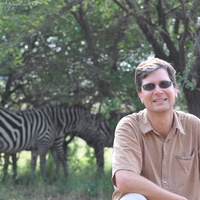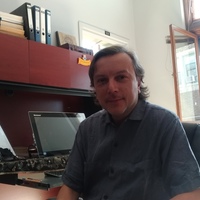
John Arthur
My present research focuses on interpreting social stratification and food production from African archaeological and living contexts. Currently, since 2005, I have been engaged in a project with Kathryn Arthur and Matthew Curtis on studying the history and prehistory of the Gamo people, who live in the highlands of southwestern Ethiopia, through the dialogue between oral history, ethnoarchaeology, life histories, and archaeology. We have revealed the origin, location, and organization of historical settlements in the region and have found evidence of households belonging to different caste groups. This research is briefly described in the Society for American Archaeology Archaeological Record published in the January 2010 issue. We have recently published in the journal Science describing a 4,500 year old male human skeleton that has provided the first complete ancient human genome sequenced from the African continent. http://blog.aaanet.org/2015/10/14/bayira-an-ancient-ethiopian-skeletal-provides-the-earliest-african-genome/
My previous ethnoarchaeological research used the life cycle approach (i.e., procurement to discard), to view the many contexts that ceramics can undergo in a complex stratified society, revealing that household ceramics are an excellent indicator of household social stratification. This research is the focus of my book published in 2006 by the University of Utah Press Foundations of Archaeological Inquiry Series and is titled, Living with Pottery: Ethnoarchaeology among the Gamo of southwest Ethiopia and peer-reviewed articles (African Archaeological Review 2014, Journal of Anthropological Archaeology 2014, Asian and African Study Monographs, Kyoto University 2013, American Antiquity 2009). My studies in Ethiopia also indicated that beer production is visible in the form of residues on archaeological ceramics, and as a consequence beer producing elite households can be distinguished from non-beer producing commoner households, (Anthropology Now 2014, Journal of Archaeological Method and Theory 2002 and World Archaeology 2003). In addition to my research in Ethiopia, I have collaboratively written with Kathryn Weedman Arthur about the methodological importance of ethnoarchaeology, which is the study of present-day material culture to help interpret the archaeological past (Handbook of Archaeological Methods 2005).
Since 2009, I have begun to work at the Weedon Island site (8PI1) in Pinellas County, Florida with USFSP students doing small test units near the shell mound. While training our students in archaeological methods, we are trying to delineate house features and to develop a method of understanding calories from the different shells we’re uncovering. By looking at the resources Native Americans were utilizing a 1000 years ago to today, we hope to determine the ecological changes Tampa Bay has has undergone over the last millennia.
I am a proud member of the Choctaw Nation of Oklahoma.
My previous ethnoarchaeological research used the life cycle approach (i.e., procurement to discard), to view the many contexts that ceramics can undergo in a complex stratified society, revealing that household ceramics are an excellent indicator of household social stratification. This research is the focus of my book published in 2006 by the University of Utah Press Foundations of Archaeological Inquiry Series and is titled, Living with Pottery: Ethnoarchaeology among the Gamo of southwest Ethiopia and peer-reviewed articles (African Archaeological Review 2014, Journal of Anthropological Archaeology 2014, Asian and African Study Monographs, Kyoto University 2013, American Antiquity 2009). My studies in Ethiopia also indicated that beer production is visible in the form of residues on archaeological ceramics, and as a consequence beer producing elite households can be distinguished from non-beer producing commoner households, (Anthropology Now 2014, Journal of Archaeological Method and Theory 2002 and World Archaeology 2003). In addition to my research in Ethiopia, I have collaboratively written with Kathryn Weedman Arthur about the methodological importance of ethnoarchaeology, which is the study of present-day material culture to help interpret the archaeological past (Handbook of Archaeological Methods 2005).
Since 2009, I have begun to work at the Weedon Island site (8PI1) in Pinellas County, Florida with USFSP students doing small test units near the shell mound. While training our students in archaeological methods, we are trying to delineate house features and to develop a method of understanding calories from the different shells we’re uncovering. By looking at the resources Native Americans were utilizing a 1000 years ago to today, we hope to determine the ecological changes Tampa Bay has has undergone over the last millennia.
I am a proud member of the Choctaw Nation of Oklahoma.
less
Related Authors
Dimitrij Mlekuz Vrhovnik
University of Ljubljana, Faculty of Arts
Nerissa Russell
Cornell University
Armando Salvatore
McGill University
Cristiana Facchini
Università di Bologna
Jennifer McKinnon
East Carolina University
Christina Tsoraki
University of Leicester
Marta Diaz-Guardamino
Durham University
Barbara Voss
Stanford University
Armando Marques-Guedes
UNL - New University of Lisbon
Julian Thomas
The University of Manchester
InterestsView All (40)










Uploads
Books by John Arthur
Papers by John Arthur
2012, we excavated three caves—Mota, Tuwatey, and
Gulo—situated at an average elevation of 2,084 m above
sea level in the cool and moist Boreda Gamo Highlands of
southwestern Ethiopia. Anthropogenic deposits in these
caves date from the Middle to Late Holocene (ca. 6000
to 100 BP) and provide excellent preservation of material
culture, fauna, flora, and human skeletal remains from
which to investigate changes in technologies and habitat
use over the last several thousand years. Here, we present
results and interpretations, suggesting ways in which Holocene
communities of the Boreda Gamo Highlands constructed
new landscapes and technologies in their transition
from hunting and gathering to an agropastoral way of life.
The Omotic-speaking Gamo represent one of the southern Ethiopia societies that are organized in a widely recognized caste system. The history of this society and the development of its caste organization are still largely unknown. Between 2006 and 2012, we organized a collaborative project with people of the Gamo district of Boreda in an effort to combine their oral traditions and life histories with archaeological investigations regarding the history of their present-day caste system. Elders claimed nine mountain-top landscapes as the original locations for Boreda settlement. One of these settlements, Garu, is an abandoned historic village site of about 60 hectares that was occupied during the 18 th-19th century CE. Archaeozoological results from Garu suggest some continuity in the practices of leatherworkers particularly in their access to specific animal parts for consumption and processing. From a methodo-logical point of view, this study illustrates how atypical data can be used to understand the diversity of animal use and provide original leads in the interpretation of prehistoric sites elsewhere. Importantly, cattle remains from Garu indicate the earliest evidence of Zebu cattle from southern Ethiopia dating to the mid-18th century.